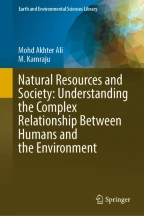Natural Resources and Globalization

Globalization is a multifaceted phenomenon characterized by the increasing interconnectedness and interdependence of countries and societies on a global scale. It involves the flow of goods, services, capital, technology, and information across borders, resulting in the integration of economies and societies (Dicken in Global shift: mapping the changing contours of the world economy, SAGE Publications, 2015). This integration has had significant implications for the utilization and trade of natural resources worldwide. This article will explore the definition of globalization and its impact on resource extraction and trade. It will also discuss the interconnectedness between global markets, resource availability, and consumption patterns.
This is a preview of subscription content, log in via an institution to check access.
Access this chapter
Subscribe and save
Springer+ Basic
€32.70 /Month
- Get 10 units per month
- Download Article/Chapter or eBook
- 1 Unit = 1 Article or 1 Chapter
- Cancel anytime
Buy Now
Price includes VAT (France)
eBook EUR 117.69 Price includes VAT (France)
Hardcover Book EUR 147.69 Price includes VAT (France)
Tax calculation will be finalised at checkout
Purchases are for personal use only
References
- Auty RM (1993) Sustaining development in mineral economies: the resource curse thesis. Routledge Google Scholar
- Bebbington A et al (2008) Mining and social movements: struggles over livelihood and rural territorial development in the Andes. World Dev 36(12):2888–2905 ArticleGoogle Scholar
- Biermann F, Buscher B (2019) Resource nationalism and the politics of fear. Int Aff 95(1):31–50 Google Scholar
- Bridge G et al (2012) The new extractivism: a post-neoliberal development model or imperialism of the twenty-first century? J Peasant Stud 39(3–4):1–32 Google Scholar
- Bridge G et al (2013) Geographies of energy transition: space, place and the low-carbon economy. Prog Hum Geogr 37(6):778–797 Google Scholar
- Carroll AB (1999) Corporate social responsibility: evolution of a definitional construct. Bus Soc 38(3):268–295 ArticleGoogle Scholar
- CBD (n.d.) Convention on biological diversity. Retrieved from https://www.cbd.int/
- Chasek PS et al (2013) Global environmental politics, 7th edn. Westview Press Google Scholar
- Dicken P (2015) Global shift: mapping the changing contours of the world economy, 7th edn. SAGE Publications Google Scholar
- Dietz S et al (2016) The political economy of energy subsidy reform. Oxf Rev Econ Policy 32(2):214–238 Google Scholar
- Dunning JH, Lundan SM (2008) Multinational enterprises and the global economy. Edward Elgar Publishing Google Scholar
- Dyllick T, Hockerts K (2002) Beyond the business case for corporate sustainability. Bus Strateg Environ 11(2):130–141 ArticleGoogle Scholar
- EITI (n.d.) Extractive industries transparency initiative. Retrieved from https://eiti.org/
- FSC (n.d.) Forest Stewardship Council. Retrieved from https://fsc.org/
- Gereffi G et al (2001) The nature of governance: policy-making in the global economy. Johns Hopkins University Press Google Scholar
- Gössling S et al (2012) Sustainable tourism futures: perspectives on systems, restructuring and innovations. Routledge Google Scholar
- Guan J, Kirikkaleli D, Bibi A, Zhang W (2020) Natural resources rents nexus with financial development in the presence of globalization: is the “resource curse” exist or myth? Resour Policy 66:101641, ISSN 0301-4207. https://doi.org/10.1016/j.resourpol.2020.101641 (https://www.sciencedirect.com/science/article/pii/S0301420720301033)
- Gylfason T et al (1999) Natural resources and economic growth: the role of investment. World Dev 27(6):1019–1030 Google Scholar
- Hansen MC et al (2013) High-resolution global maps of 21st-century forest cover change. Science 342(6160):850–853 ArticleGoogle Scholar
- Hirsch P (2014) Resource nationalism in the 21st century. J Int Aff 68(1):55–71 Google Scholar
- Humphreys M et al (2007) Ownership, control, access, and possession (OCAP) or self-determination applied to research: a critical analysis of contemporary first nations research and some options for first nations communities. J Aboriginal Health 3(1):80–95 Google Scholar
- Korhonen J et al (2018) Circular economy as an essentially contested concept. J Clean Prod 175:544–552 ArticleGoogle Scholar
- Laurance WF et al (2014) Averting biodiversity collapse in tropical forest protected areas. Nature 489(7415):290–294 ArticleGoogle Scholar
- Le Billon P (2012) Wars of plunder: conflicts, profits and the politics of resources. Columbia University Press Google Scholar
- Leichenko R, O’Brien K (2008) Environmental change and globalization: double exposures. Oxford University Press Google Scholar
- Millenium Ecosystem Assessment (2005) Ecosystems and human well-being: synthesis. Island Press Google Scholar
- Oetzel J (2017) International business and the natural environment: a research overview and agenda. J World Bus 52(3):385–399 Google Scholar
- Pegg S (2006) Corporate social responsibility in the mining industry: exploring trends in social and environmental disclosure. J Clean Prod 14(3–4):271–284 Google Scholar
- RJC (n.d.) Responsible Jewellery Council. Retrieved from https://www.responsiblejewellery.com/
- Ricardo D (1817) On the principles of political economy and taxation Google Scholar
- Ross ML (1999) The political economy of the resource curse. World Polit 51(2):297–322 ArticleGoogle Scholar
- Ross ML (2012) The oil curse: how petroleum wealth shapes the development of nations. Princeton University Press Google Scholar
- Ross ML (2015) What have we learned about the resource curse? Annu Rev Polit Sci 18:239–259 ArticleGoogle Scholar
- Sachs JD, Warner AM (1997) Natural resource abundance and economic growth. NBER Working Paper No. 5398 Google Scholar
- Sachs W, Santarius T (2007) Fair future: resource conflicts, security, and global justice. Zed Books Google Scholar
- Sikor T, Lund C (2009) Access and property: a question of power and authority. Dev Change 40(1):1–22 ArticleGoogle Scholar
- UN (2011) guiding principles on business and human rights: implementing the United Nations “protect, respect and remedy” framework. Retrieved from https://www.ohchr.org/
- UN (2015) Transforming our world: the 2030 agenda for sustainable development. Retrieved from https://www.un.org/sustainabledevelopment/
- UNEP (2011) Towards a green economy: pathways to sustainable development and poverty eradication. Retrieved from https://www.unep.org/
- UNFCCC (2015) Paris agreement. Retrieved from https://unfccc.int/process-and-meetings/the-paris-agreement/the-paris-agreement
- Wang S et al (2019) Environmental impacts of mining activities: emphasis on mitigation and remedial measures. Environ Sci Pollut Res 26(25):25469–25488 Google Scholar
Author information
Authors and Affiliations
- Department of Geography, University college of science, Osmania University, Hyderabad, India Mohd Akhter Ali
- Division of Graduate Studies, Department of Geography, Centre for Economic Studies, Nizamiah Observatory Campus, Hyderabad, Telangana, India M. Kamraju
- Mohd Akhter Ali

